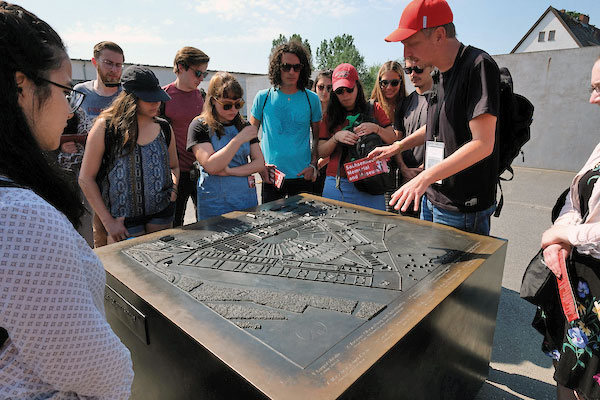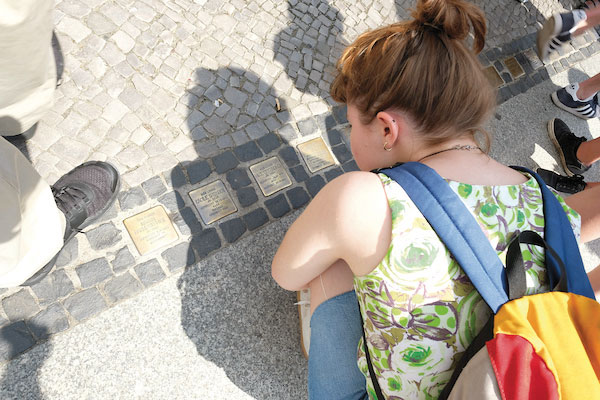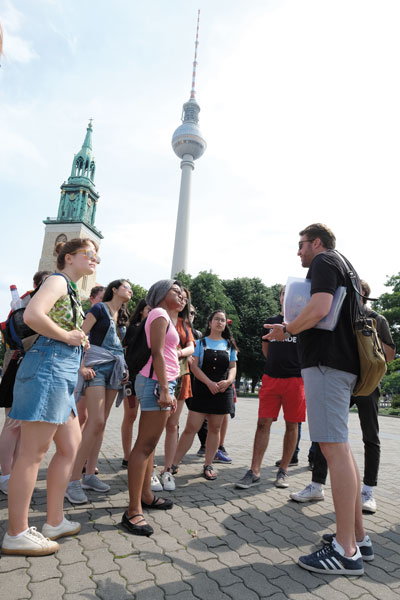Last June, Priyanka Dangol ’21, 13 other Grinnell students, and their two professors stood at the visually stunning Wannsee villa on the outskirts of Berlin, Germany. Together they confronted the meaning of the site where Nazi and Schutzstaffel leaders met in January 1942 to plan the Final Solution — code name for the extermination of European Jews. Not a tourist destination in any conventional sense, it is a place to be approached with preparation and intention.
“Learning about it in a book,” Dangol says, “you see only black-and-white pictures, and you can’t really situate yourself. But when you actually go there, you see this beautiful lake and the beautiful beach and the green scenery. It hits you that the people who were making these vile decisions were in the exact same beautiful surroundings. And still they made those destructive horrifying decisions to kill millions of people.
“Going there, and going to concentration camps (Sachsenhausen and Natzweiler-Struthof) was hard to take but also very eye-opening,” she adds. “To see for yourself the surroundings in which people had to endure all this torture made the whole idea so much more real. You really start empathizing when you get to see detailed accounts of victims’ lives.”
The sites to which Dangol refers were among many during three weeks of travel in France and Germany that capped off a spring 2019 Global Learning Program (GLP) seminar on tolerance and intolerance in Europe from the Reformation to current times. The first-ever GLP course for second-year students was modeled after first-year GLP tutorials characterized by cross-disciplinary work, provocative contemporary questions, multi-geographical comparative studies, and international travel.
“The trip, and the whole course, gave me a much more holistic idea of things that I had very little knowledge about before,” Dangol says. “I think it is one of the greatest experiences I’ve had so far in my two years at Grinnell.”
Evolution of GLP 2.0
 David Harrison, professor of French, designed and team-taught the new GLP course with Daniel Reynolds, Seth Richards Professor of Modern Languages and professor of German studies. They taught a similar GLP course in 2016 for first-year students. Harrison says the GLP structure is so effective because it integrates “all the best aspects
David Harrison, professor of French, designed and team-taught the new GLP course with Daniel Reynolds, Seth Richards Professor of Modern Languages and professor of German studies. They taught a similar GLP course in 2016 for first-year students. Harrison says the GLP structure is so effective because it integrates “all the best aspects
of the Grinnell curriculum.” The GLP was made possible by the generous support of Susan Holden McCurry ’71 and the Roland and Ruby Holden Foundation. Expanding and deepening the GLP offering for second-year students made the extended travel experience even more critical.
“We don’t just go to a site for a few days, do some research, and come back,” Harrison says. “It’s about really in-depth trying to get to know a site, or several sites. The experiential learning aspect of the travel, the comparative nature of the travel component — the fact that we go to France and Germany, as well as Strasbourg on the border of those two countries — makes this something quite different from a regular Grinnell course.
“And,” Harrison adds, “it’s important to note that the course is not just for beginners. It requires in this case four semesters of language studies in French or German, so there is some preparation involved.”
Guaranteeing a minimal level of proficiency in either language meant that “everyone in the class would be able to converse with the locals on site,” Reynolds says. “And there would also be someone in the group who could translate signs, help navigate the rail system, help order food, those kinds of things.”
Another difference Reynolds saw with the second-year GLP course: “The students have a year of Grinnell under their belt, so they’re a little more confident about their ability to speak as intellectuals with scholars that we meet on the trip. They’re more sure of themselves in terms of why they’re in the class, what they’re going to do with the knowledge in the class.”
Purposeful research
“We really want the students to have a solid foundation for exploring present-day conversations about racism, migration, and political formations around nationalism, neo-nationalism, et cetera,” Reynolds says. “So, because these things that we’re facing today have a long pre-history, I think it’s important for students to understand how the debates we’re having today are framed by that historical process.”
During the course, each student proposed a research project related to the seminar’s central question in the context of the history and current conditions in France and Germany —namely, can we live together with people whose values and beliefs are fundamentally different from ours?
 “Our course explores how the idea of tolerance manifests itself as a philosophical idea, both in terms of the last couple of hundred years in France and Germany and in how the countries return to those philosophical debates in addressing current-day political and social questions,” Harrison says. “For example, whether we’re talking about the increase of Muslim populations or the expression of anti-Semitic actions, how do these two nations deal with those forms of intolerance today after all the things that have gone before?”
“Our course explores how the idea of tolerance manifests itself as a philosophical idea, both in terms of the last couple of hundred years in France and Germany and in how the countries return to those philosophical debates in addressing current-day political and social questions,” Harrison says. “For example, whether we’re talking about the increase of Muslim populations or the expression of anti-Semitic actions, how do these two nations deal with those forms of intolerance today after all the things that have gone before?”
The students’ research projects, approved by midsemester, were completed and submitted prior to the travel. That, too, was purposeful. “The idea was that the research and writing they’d done would be the basis for their being able to interact with people abroad and to deepen their knowledge,” Harrison explains. “It also deepened the conversation among the entire group when we went to different sites so that each student, based on their research, could help inform the conversations.”
The result, Harrison says, was that students were more engaged. They approached interactions with a stronger background in the issues, and “were able to ask questions of people one-on-one in a way that was very in-depth.” Student research also informed the course’s travel itinerary, which was built around scholarship rather than tourism. Reynolds describes it as giving history “some real geographical space.”
Harrison says, “We chose sites that were very focused on the topics we’d been studying, as well as speakers and lecturers that most visitors traveling abroad wouldn’t choose because they require a certain level of knowledge to appreciate them. One such place was the New Synagogue of Berlin, which represents the entire tradition of Berlin Judaism and its complex history over the past two centuries. That would not be a typical stop for tourists, or even a school group going to Berlin.”
Inspired to learn more
During the classroom portion of the course prior to the travel, Avery Lewis ’21 elected to research the various aspects of visually offensive materials, including how visual “offense” differs from textual and other forms. Specifically, he looked at depictions of the prophet Mohammed that have been published in the French satirical magazine Charlie Hebdo.
“My argument basically was that when we think about what is and isn’t offensive, the mediums through which it is depicted have to be taken into account,” Lewis says. “There are psychological, theoretical, and other grounds in which a visual offense can, in some instances, be much more offensive than other forms. I don’t think that’s talked about enough.”
Lewis, who cited Sachsenhausen, Natzweiler, and the Drancy (Paris) deportation camp as the most powerful and emotional experiences from the group’s travels, pointed to two sessions in Strasbourg that expanded his perceptions related to his research topic.
“At the Grand Mosque, I got a lot of information from my tour guide that made me rethink some of my arguments, or at least showed me I need to dive a little bit deeper into religious groundings and the beliefs around them before I can make a claim about a certain group of people,” Lewis says.
“Secondly, a big part of my project was about constitutionally what is and what isn’t protected under definitions of hate speech,” Lewis says. “Our lecture at the Council of Europe made me realize how much more complicated judicial systems are in Europe.
 “It made me want to learn more about how the branches of the judicial systems work in each country in comparison to the overall European court of human rights, and to learn more about the complexities of my paper,” he says. “Even though I still stand by my argument, I would want to do a lot more research on it.”
“It made me want to learn more about how the branches of the judicial systems work in each country in comparison to the overall European court of human rights, and to learn more about the complexities of my paper,” he says. “Even though I still stand by my argument, I would want to do a lot more research on it.”
Lewis says the GLP experience not only reaffirmed his desire to travel, it instilled in him the importance of traveling with intention, with a specific purpose or for a specific cause. “It also reaffirmed for me the importance of learning language, or as many languages as you can,” he says.
Shaping future aspirations
For Cinthia Romo ’21, the GLP seminar provided perspectives specific to her career plans. She says being able to interview people at nongovernmental organizations (NGOs) — most notably SOS Racism in Paris — provided “a different take on approaches to multiculturalism and race that are outside of the American context where I’m surrounded by it all the time.”
Having conducted her seminar research on the role of modern-day intellectuals in public society and academia, Romo says a lecture by a specialist in populism “reaffirmed what I had found about the role of the intellectual in politics, and in general put me on track in terms of what I want to do in future.”
The European trip also segued into her internship at a restorative justice agency in Maine this summer, and she drew comparisons about how models for restorative justice in individual trauma cases may be applied to historical traumas and broader concepts of tolerance.
“The best way to describe it is that the victim of a crime comes together with offender,” Romo says, ”so that the offender can assume responsibility and the victim can talk about whatever harm that has been done. It’s really effective and has been shown to reduce recidivism among offenders and also has reduced PTSD in victims.”
Romo added, “I think this course was really beneficial in seeing historical traumas through a more intense perspective in order to understand people’s experiences.”
Perspectives on tolerance
While many GLP students report a favorable impression of Germany’s efforts to remember and memorialize victims of the Holocaust, individual research produced some nuance in those impressions. After extensively researching the evolution of hip-hop as an expression of social and immigration issues in Germany, Linnet Adams ’21 says there are other areas where more could be done.
“When we were in Berlin, never once did we see any mention of what Germany has done to negatively affect the African community,” Adams says. “I never saw any monuments about it. I never saw anything about Namibia. A bunch of streets are still named after German colonial figures and parts of Africa that became colonized, so those things affirm to me that while Germany is doing a pretty good job at confronting what was done by Nazis, they still have a long way to go when it comes to what they did in the late 19th century and what they’re doing in the present.”
Unforgettable
 In an experience similar to Dangol’s epiphany at Wannsee, Adams recounts an impression from Berlin that was framed by classroom references and pre-travel preparation.
In an experience similar to Dangol’s epiphany at Wannsee, Adams recounts an impression from Berlin that was framed by classroom references and pre-travel preparation.
“At the Holocaust memorial, there are about 2,500 [stelae] or blocks between 0 and 4 meters tall,” Adams says. “There were regulations placed around the memorial that are hidden in plain sight; not many people can see them but they’re there. We saw a lot of people like standing on them [the blocks], taking pictures, posing. I along with everybody else found it very jarring to see them being so disrespectful.
“It reminded me of talking in class months before about what we should do when it comes to taking pictures at these types of sites, or at concentration camps,” Adams says. “One particular student brought up a Berlin-based Israeli comedian’s project where he found social media pictures of people disrespecting Holocaust memorial sites, and he was basically publicly shaming them.
“The behaviors we had seen from that project were what we saw at the Holocaust memorial. I just couldn’t believe that people still do it. I don’t think I’ll ever forget that.”
High expectations, difficult questions
In assessing the success of the new course, Harrison says he and Reynolds were gratified that the 14 GLP students “completely lived up to our expectations” given the increased depth and demands of the second year seminar.
“We saw a moral growth in being able to recognize that the questions we were dealing with were difficult questions with no easy solutions, and that the kinds of easy answers that students might have coming into the course are not as applicable when they left the course,” Harrison says.
“Students recognized that tolerance, or the practice of tolerance, is not easy — that it actually constantly requires questions and dialogue,” he says. “It is not just a matter of ‘we like everyone,’ because that’s not what tolerance is. Tolerance is really being able to live with people that you disagree with or that have ideas that you find disagreeable.”
“The GLP is an incredible learning opportunity for students, but also for faculty,” Reynolds says, “It’s probably one of the most exciting new features of our curriculum in recent times. Word has gotten out to students. They want to come to Grinnell because of the GLP."
Priyanka Dangol ’21 is a computer science major from Kathmandu, Nepal; Avery Lewis ’21 is a political science and English double major from Beloit, Wisconsin; Cinthia Romo ’21 is a sociology and French double major from Kansas City, Kansas; Linnet Adams ’21 is a German and history double major from New Orleans.